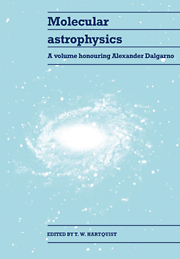Book contents
- Frontmatter
- Contents
- Dedication
- Preface
- Part I Molecular clouds and the distribution of molecules in the Milky Way and other galaxies
- Part II Diffuse molecular clouds
- Part III Quiescent dense clouds
- Part IV Studies of molecular processes
- 9 Molecular photoabsorption processes
- 10 Interstellar ion chemistry: laboratory studies
- 11 Theoretical considerations on some collision processes
- 12 Collisional excitation processes
- 13 Neutral reactions at low and high temperatures
- Part V Atomic species in dense clouds
- Part VI H2 in regions of massive star formation
- Part VII Molecules near stars and in stellar ejecta
- Part VIII Moderately ionized gas and chemistry at large redshifts
- Index
10 - Interstellar ion chemistry: laboratory studies
Published online by Cambridge University Press: 10 December 2009
- Frontmatter
- Contents
- Dedication
- Preface
- Part I Molecular clouds and the distribution of molecules in the Milky Way and other galaxies
- Part II Diffuse molecular clouds
- Part III Quiescent dense clouds
- Part IV Studies of molecular processes
- 9 Molecular photoabsorption processes
- 10 Interstellar ion chemistry: laboratory studies
- 11 Theoretical considerations on some collision processes
- 12 Collisional excitation processes
- 13 Neutral reactions at low and high temperatures
- Part V Atomic species in dense clouds
- Part VI H2 in regions of massive star formation
- Part VII Molecules near stars and in stellar ejecta
- Part VIII Moderately ionized gas and chemistry at large redshifts
- Index
Summary
Introduction
The wide variety of ionized and neutral molecules detected in diffuse and dense interstellar clouds are mainly synthesized in the gas phase by many sequential and parallel positive ion–neutral reactions. The product positive ions may then be neutralized by proton transfer or charge transfer reactions with ambient molecules and/or via dissociative positive ion–electron recombination reactions and/or (as has recently been proposed) via mutual neutralization (positive ion–negative ion recombination) reactions involving large negatively-charged molecules. The basic gas phase ion chemistry was outlined in the early 1970s (Solomon and Klemperer 1972, Herbst and Klemperer 1973, Dalgarno 1975, Dalgarno and Black 1976) and since that time more sophisticated quantitative ion–chemical models have been developed to describe the routes to, and relative abundances of, the increasing number of complex molecules detected in interstellar clouds (Leung, Herbst and Huebner 1984, Millar and Nejad 1985, Dalgarno 1986, van Dishoeck and Black 1986, Millar, Leung and Herbst 1987). These models require the input of a large amount of kinetic data which (ideally) has been obtained at the low temperatures pertaining to interstellar clouds. In particular, the rate coefficients and products of many positive ion–neutral reactions and recombination reactions are required. Hence, a good deal of effort has been made to design and exploit laboratory experiments to provide these data (Huntress 1977, Smith and Adams 1981a, Anicich and Huntress 1986, Adams and Smith 1987a, Rowe 1988, Adams and Smith 1988a). This has led to a better understanding of the molecular processes that can occur under the extreme conditions of low pressure and low temperature in quiescent interstellar clouds.
- Type
- Chapter
- Information
- Molecular AstrophysicsA Volume Honouring Alexander Dalgarno, pp. 181 - 210Publisher: Cambridge University PressPrint publication year: 1990
- 7
- Cited by

